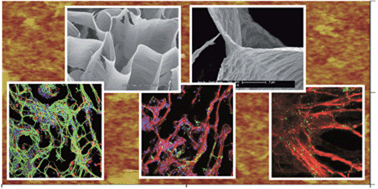3D free-standing porous scaffolds made of graphene oxide as substrates for neural cell growth†
Abstract
The absence of efficient therapies for the treatment of lesions affecting the central nervous system encourages scientists to explore new materials in an attempt to enhance neural tissue regeneration while preventing inhibitory fibroglial scars. In recent years, the superlative properties of graphene-based materials have provided a strong incentive for their application in biomedicine. Nonetheless, a few attempts to date have envisioned the use of graphene for the fabrication of three-dimensional (3D) substrates for neural repair, but none of these involve graphene oxide (GOx) despite some attractive features such as higher hydrophilicity and versatility of functionalization. In this paper, we report novel, free-standing, porous and flexible 3D GOx-based scaffolds, produced by the biocompatible freeze-casting procedure named ISISA, with potential utility in neural tissue regeneration. The resulting materials were thoroughly characterized by Fourier-transform infrared, Raman, and X-ray photoelectron spectroscopies and scanning electron microscopy, as well as flexibility testing. Embryonic neural progenitor cells were then used to investigate adhesion, morphology, viability, and neuronal/glial differentiation. Highly viable and interconnected neural networks were formed on these 3D scaffolds, containing both neurons and glial cells and rich in dendrites, axons and synaptic connections, and the results are in agreement with those obtained in initial studies performed with two-dimensional GOx films. These results encourage further investigation in vivo on the use of these scaffolds as guide substrates to promote the repair of neural injuries.


 Please wait while we load your content...
Please wait while we load your content...